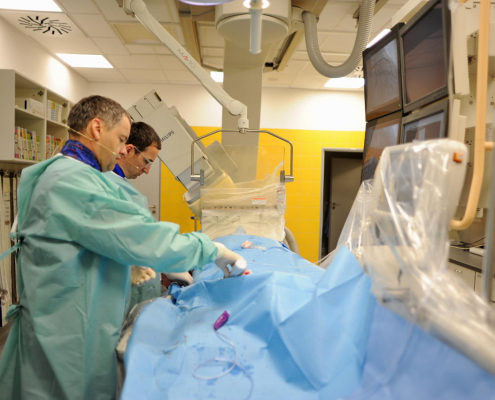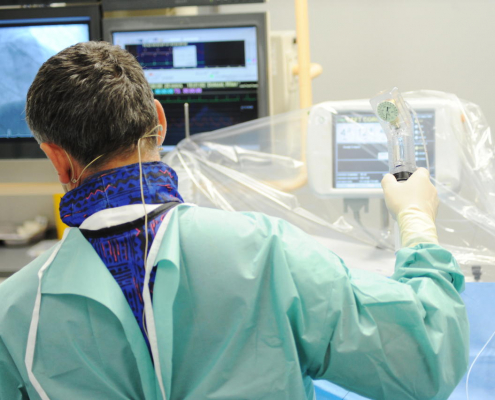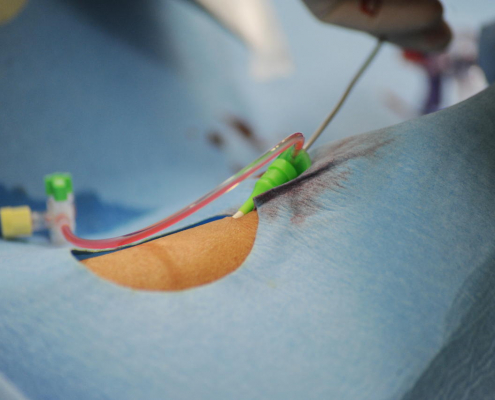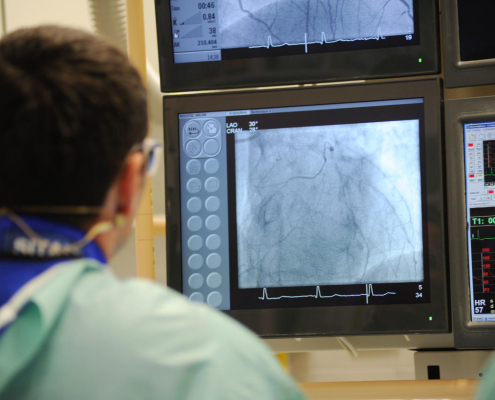ACUTE CORONARY SYNDROMES
MUDr. Ota Hlinomaz, CSc.
Established in 2016*
Key words
Interventional cardiology, stent, scaffold, coronary artery disease, myocardial infarction, percutaneous coronary intervention, tako-tsubo ardiomyopathy, ST-Elevation myocardial infarction
Research focus
The Acute Coronary Syndrome Research team belongs amongst pioneers of primary percutaneous coronary intervention programs in the Czech Republic and is also one of the largest centers. The main activity of the ACS Research team is interventional cardiology, treatment of coronary artery disease by percutaneous coronary interventions and treatment of acute coronary syndromes. The main research is focused on a new stent and scaffolds development, treatment of ST-Elevation Myocardial Infarction (STEMI) patients with multivessel disease, anti-aggregation therapy after acute coronary syndromes, Tako-tsubo Cardiomyopathy, new imaging methods of coronary arteries and atherosclerotic plaque progression.
Research objectives
• Evaluate unstable coronary plaques by optical coherence tomography and near infrared spectroscopy.
• Test newly developed coronary stents and scaffolds in animal models and humans.
• Test the role of genetic polymorphisms on pharmacokinetics of antiplatelet drugs used for acute coronary syndromes treatment.
Technological equipment
• Angiography System – Digital Subtraction Angiography (DSA)
• Optical Coherence Tomography (OCT)
• Near Infrared Spectroscopy (NIRS)
• Intracoronary Ultrasound (IVUS)
• Single-Photon Emission Computed Tomography (SPECT)
Top publications
- UTHAMARAJ, S., TEFFT, B., HLINOMAZ, O., SANDHU, G., DRAGOMIR-DAESCU, D. Ferromagnetic Bare Metal Stent for Endothelial Cell Capture and Retention. Jove-Journal of Visualized Experiments. 2015, SEP(103), e53100.
- UTHAMARAJ, S., TEFFT, B., KLABUSAY, M., HLINOMAZ, O., SANDHU, G., DRAGOMIR-DAESCU, D. Design and Validation of a Novel Ferromagnetic Bare Metal Stent Capable of Capturing and Retaining Endothelial Cells. Annals of Biomedical Engineering. 2014, 42(12), 2416-2424.
- MÁCHAL, J., PÁVKOVÁ-GOLDBERGOVÁ, M., HLINOMAZ, O., GROCH, L., VAŠKŮ, A. Patients with chronic three-vessel disease in a 15-year follow-up study: genetic and non-genetic predictors of survival. Medicine. 2014, 93(28), e278.
- PLEVA, L., KUKLA, P., KUSNIEROVA, P., ZAPLETALOVA, J., HLINOMAZ, O. Comparison of the Efficacy of Paclitaxel-Eluting Balloon Catheters and Everolimus-Eluting Stents in the Treatment of Coronary In-Stent Restenosis The Treatment of In-Stent Restenosis Study. Circulation-Cardiovascular Interventions. 2016, 9(4), e003316.
- KINCL, V., MÁCHAL, J., DROZDOVÁ, A., PANOVSKÝ, R., VAŠKŮ, A. The Relation between eNOS -786 C/T, 4 a/b, MMP-13 rs640198 G/T, Eotaxin 426 C/T, -384 A/G, and 67 G/A Polymorphisms and Long-Term Outcome in Patients with Coronary Artery Disease. Disease Markers. 2015, 2015(2015), 232048.
Other selected results
- Novel Ferromagnetic Bare Metal Stent Capable of Capturing and Retaining Endothelial Cells – New type of stent for Rapid healing of vascular system reducing complications associated with stent thrombosis, restenosis, and bleeding related to antiplatelet drugs.
- Novel Ferromagnetic Stent Graft – New type ofstent graft with small diameter (3 mm) – magnetic stent graft of rapid endothelialization represents a new therapeutic approach in peripheral and coronary arteries, thereby reducing the need for prolonged anticoagulation and antiplatelet therapy.
STRATEGY FOR THE PERIOD 2021 – 2025
The Acute Coronary Syndrome Research team belongs amongst pioneers of primary percutaneous coronary intervention program in the Czech Republic and is also one of the largest centers. The main activity of the ACS Research team is interventional cardiology, treatment of coronary artery disease by percutaneous coronary interventions and treatment of acute coronary syndromes. The main research is focused on treatment of ST-Elevation Myocardial Infarction (STEMI) patients with multivessel disease, a new stent and scaffolds development, Tako-tsubo Cardiomyopathy, spontaneous coronary artery dissections (SCAD), new imaging methods of coronary arteries and atherosclerotic plaque progression. We participate in the multicenter, international, randomized DAPT-SHOCK PRAGUE-23 trial, which compares cangrelor to ticagrelor in patients with cardiogenic shock due to acute myocardial infarction. Most of the patients are evaluated by MRI and echocardiography. The hypothesis is that cangrelor is superior to ticagrelor in these high-risk patients. We will work on the 10-year follow up of the patients in Prague-13 trial comparing the PCI versus the conservative treatment of non-culprit coronary stenoses in patients with STEMI treated by primary PCI. We expect better long-term results in the PCI group. We will publish the results of our analysis comparing the 15-year and 20-year survival amongst patients presenting with chronic stable angina who had smooth coronary vessels, no obstructive and obstructive coronary artery disease on invasive coronary angiography.
We will evaluate unstable coronary plaques by optical coherence tomography and near infrared spectroscopy. These unstable plaques will be treated by stent implantation. We expect a better prognosis in these patients in comparison to conservatively treated patients.
Newly developed coronary stents and scaffolds will be tested in humans and compared to currently used stent. Patients with spontaneous coronary artery dissections will be deeply examined and followed. We will participate at the European multicenter registry. We hope to find the factors that influence the long-term prognosis of our patients. Patients with advanced heart failure due to reduced systolic function of the left ventricle will be treated by the AccuCinch system. Improved exercise tolerance and better prognosis after device implantation is expected. We will participate in pilot clinical trial with this system. We will collaborate with CINRE hospital in Bratislava, Slovakia, Institute of Cardiology in Minsk, Belarus, Bulgarian Cardiac Institute in Pleven and Varna, Leicester Research Group from England and Mayo Clinic, USA.









